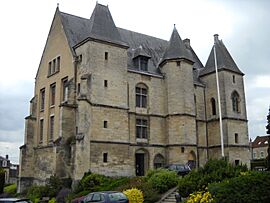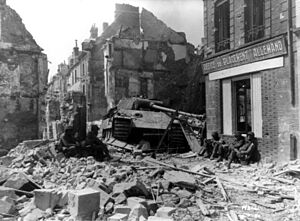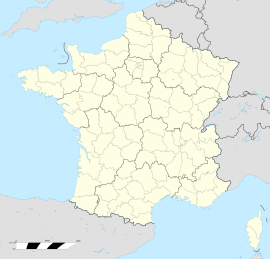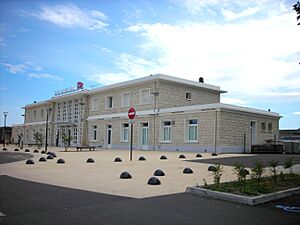Argentan facts for kids
Quick facts for kids
Argentan
|
||
|---|---|---|
|
Subprefecture and commune
|
||

The château of the dukes in the centre of Argentan
|
||
|
||
| Country | France | |
| Region | Normandy | |
| Department | Orne | |
| Arrondissement | Argentan | |
| Canton | Argentan-1 Argentan-2 |
|
| Intercommunality | Terres d'Argentan Interco | |
| Area
1
|
18.18 km2 (7.02 sq mi) | |
| Population
(2022)
|
13,494 | |
| • Density | 742.24/km2 (1,922.4/sq mi) | |
| Time zone | UTC+01:00 (CET) | |
| • Summer (DST) | UTC+02:00 (CEST) | |
| INSEE/Postal code |
61006 /61200
|
|
| Elevation | 152–228 m (499–748 ft) | |
| 1 French Land Register data, which excludes lakes, ponds, glaciers > 1 km2 (0.386 sq mi or 247 acres) and river estuaries. | ||
Argentan is a town in northwestern France. It is located in the Orne area, which is like a county. Argentan is an important town, serving as a main center for two smaller areas called cantons and a larger area called an arrondissement. In 2019, it was the third-largest town in the Orne department by population.
Contents
History of Argentan
Early Beginnings
Argentan is found near the Orne River. Even though many people lived in this area during the time of the Romans and Gauls, the town of Argentan itself wasn't written about until the 11th century. Its name comes from old Gaulish words meaning "silver" and "market." The town became more important during the Middle Ages.
Medieval Times
The town's defenses were built or rebuilt by Rollo, the first duke of Normandy. In 1046, Henry I of France attacked Argentan, destroying its walls. Later, in 1094, Roger the Poitevin tried to defend the town for William II of England but gave up quickly.
After a big battle in 1106, Henry I of England decided to make Argentan's defenses even stronger. He built new walls and the first version of the dukes' castle. In 1199, John, King of England took control of the town for a short time. But by 1203, Philip II of France had taken it over.
During the Hundred Years' War, the English took control of Argentan in 1356. They left four years later. In 1372, Pierre II, Count of Alençon, bought the town. He built several chapels and the castle that you can still see today.
In 1417, Henry V of England captured Argentan. The English stayed until 1449, when Charles VII of France took back control of Normandy, ending the Hundred Years' War in 1453.
In 1465, Francis II, Duke of Brittany, briefly took the town. This was part of a protest against King Louis XI wanting a stronger central government in France. Louis XI quickly got the castle back and made a peace treaty.
Later, the castle walls around the city began to be taken down. This happened because René, Duke of Alençon, got his family's lands back. Also, new weapons like gunpowder made old stone walls less useful in battles.
Modern Era
During the French Wars of Religion, Protestants led by Gaspard II de Coligny captured Argentan. But in 1574, Catholic soldiers forced them out.
Under King Louis XIV, a minister named Jean-Baptiste Colbert wanted France to make its own luxury goods. He gave special permission for towns in the Orne area to make lace. In 1665, Argentan and nearby Alençon became famous for their beautiful lace. The "Argentan stitch" and "Alençon stitch" were considered the best in France. Argentan became an important town for traditional crafts. It also grew in religious importance, with a Benedictine Abbey and two churches, Saint-Martin and Saint-Germain, being built. Many fancy houses were also constructed.
Twentieth Century Events
During World War I, a French army regiment was stationed in Argentan. They fought in the Battle of Verdun in 1916.

In World War II, Argentan was almost completely destroyed. On June 5, 1944, just before the D-Day landing in Normandy, the town was heavily bombed. The train station was ruined. More bombs fell on June 6 and 7. The worst damage happened in late August during the battle of the Argentan-Falaise Pocket. The U.S. Third Army, led by General George S. Patton, freed Argentan after eight days of fierce fighting. The U.S. 80th Infantry Division liberated the city on the morning of August 20.
Geography and Nature
The town of Argentan includes the main town and smaller areas like La Croix de Coulandon, Coulandon, and Mauvaisville. The commune covers about 18 square kilometers. Its highest point is 228 meters, and its lowest is 152 meters.
Argentan is located right on the Greenwich Meridian line, which is marked at its eastern entrance.
Five waterways flow through Argentan: the Orne, the Ure, the Baize rivers, and two streams, the Marais de Fleuriel and the Fontaines Thiot.
The commune is part of an area called the Plaine d'Argentan. This region is known for its fields where cereals are grown and for its horse stud farms.
Argentan is also part of a large Natura 2000 conservation area, covering over 20,000 hectares. This area is called the Haute vallée de l'Orne et affluents.
Land Use
Most of the land in Argentan, about 45%, is used for growing crops. About 23% of the land is urbanized, meaning it has buildings and roads. Another 13% is used for industrial and commercial purposes. The rest of the land includes meadows (18%), forests (0.11%), and artificial green spaces (2%).
Location and Travel
Argentan is about 180 kilometers northeast of Rennes and 58 kilometers southeast of Caen. It has train connections to Caen, Le Mans, Paris, and Granville.
 |
Sévigny | Gouffern en Auge |  |
|
| Moulins-sur-Orne & Sarceaux | Sai | |||
| Boischampré | Juvigny-sur-Orne |
Climate
Argentan has a temperate oceanic climate. This means it has mild temperatures and rainfall throughout the year.
| Climate data for Argentan, 1991–2021 normals, elevation: 170 m (558 ft), extremes 1991–present, 1991 - 2019 Average sun hours | |||||||||||||
|---|---|---|---|---|---|---|---|---|---|---|---|---|---|
| Month | Jan | Feb | Mar | Apr | May | Jun | Jul | Aug | Sep | Oct | Nov | Dec | Year |
| Record high °C (°F) | 16.9 (62.4) |
21.1 (70.0) |
24.4 (75.9) |
27 (81) |
30 (86) |
37.2 (99.0) |
40.2 (104.4) |
38.3 (100.9) |
33.4 (92.1) |
28.8 (83.8) |
21.1 (70.0) |
16.6 (61.9) |
40.2 (104.4) |
| Mean daily maximum °C (°F) | 7.4 (45.3) |
8.7 (47.7) |
11.8 (53.2) |
15.2 (59.4) |
18.4 (65.1) |
22 (72) |
24.4 (75.9) |
24.1 (75.4) |
20.8 (69.4) |
16.2 (61.2) |
11.1 (52.0) |
8 (46) |
15.7 (60.3) |
| Daily mean °C (°F) | 4.6 (40.3) |
5.2 (41.4) |
7.3 (45.1) |
9.7 (49.5) |
13 (55) |
16.2 (61.2) |
18.3 (64.9) |
18.2 (64.8) |
15.2 (59.4) |
12.1 (53.8) |
7.9 (46.2) |
5 (41) |
11.1 (52.0) |
| Mean daily minimum °C (°F) | 1.7 (35.1) |
1.8 (35.2) |
2.9 (37.2) |
4.3 (39.7) |
7.5 (45.5) |
10.4 (50.7) |
12.1 (53.8) |
12.2 (54.0) |
9.6 (49.3) |
7.9 (46.2) |
4.7 (40.5) |
2.1 (35.8) |
6.4 (43.5) |
| Record low °C (°F) | −14.7 (5.5) |
−12.9 (8.8) |
−9.2 (15.4) |
−6.6 (20.1) |
−2.8 (27.0) |
0.1 (32.2) |
2.7 (36.9) |
2.2 (36.0) |
0 (32) |
−6.9 (19.6) |
−7.7 (18.1) |
−13 (9) |
−14.7 (5.5) |
| Average precipitation mm (inches) | 62.5 (2.46) |
54.4 (2.14) |
51.3 (2.02) |
48.6 (1.91) |
60.2 (2.37) |
47.1 (1.85) |
50.4 (1.98) |
54.8 (2.16) |
50.2 (1.98) |
69.7 (2.74) |
68.2 (2.69) |
74.5 (2.93) |
691.9 (27.24) |
| Average precipitation days (≥ 1.0 mm) | 12.3 | 11.6 | 10.2 | 9.3 | 9.6 | 8.3 | 8.5 | 8.7 | 8 | 11.6 | 12.7 | 13.9 | 124.7 |
| Average relative humidity (%) | 87 | 83 | 79 | 74 | 74 | 72 | 71 | 72 | 76 | 82 | 87 | 87 | 79 |
| Mean monthly sunshine hours | 86.8 | 106.4 | 161.2 | 220.1 | 232.5 | 252 | 263.5 | 241.8 | 195 | 145.7 | 102 | 96.1 | 2,103.1 |
| Source 1: Météo France | |||||||||||||
| Source 2: Climate data (relative humidity & Average Sunshine hours) | |||||||||||||
Population Growth
| Historical population | ||||||||||||||||||||||||||||||||||||||||||||||||||||||||||||||||||||||||||||||||||||||||||||||||||||||||||||||||
|---|---|---|---|---|---|---|---|---|---|---|---|---|---|---|---|---|---|---|---|---|---|---|---|---|---|---|---|---|---|---|---|---|---|---|---|---|---|---|---|---|---|---|---|---|---|---|---|---|---|---|---|---|---|---|---|---|---|---|---|---|---|---|---|---|---|---|---|---|---|---|---|---|---|---|---|---|---|---|---|---|---|---|---|---|---|---|---|---|---|---|---|---|---|---|---|---|---|---|---|---|---|---|---|---|---|---|---|---|---|---|---|---|
|
|
|||||||||||||||||||||||||||||||||||||||||||||||||||||||||||||||||||||||||||||||||||||||||||||||||||||||||||||||
| Source: EHESS and INSEE (1968–2017) | ||||||||||||||||||||||||||||||||||||||||||||||||||||||||||||||||||||||||||||||||||||||||||||||||||||||||||||||||
Main Sights and Buildings
- Donjon of Argentan - These are parts of the old walls of Argentan, built in the Middle Ages by Henry I of England. They were recognized as a historic monument in 1945.
- Tour Marguerite - A tower from the 12th century, also built by Henry I of England. It became a historic monument in 1965.
- Castle of the Dukes - A 14th-century castle built by Pierre II of Alençon. Today, it serves as a court house. It was recognized as a historic monument in 1889. The castle grounds also have the 14th-century St. Nicholas Chapel, which is also a historic monument.
- Saint Martin church - Built in the 16th century, this church was listed as a historic monument in 1862.
- Saint Germain church - A 15th-century church, listed as a historic monument in 1889.
- Saint Roch Chapel
Other Historic Sites
Argentan has 18 buildings and areas listed as National Heritage sites. Besides the ones mentioned above, these include:
- Hotel du Moulin de Fontenelle - An 18th-century L-shaped hotel, added as a monument in 2004.
- Former Hotel Servain - A 17th-century hotel, whose door was added as a monument in 1948.
- Henri IV House - Built in 1623, it was the town hall from 1722 to 1809. It was classified in 1946.
- Hôtel Ango-de-la-Motte - A former 17th-century hotel, classified in 1948.
- Three Crosses Column - Set up in 1771, these three crosses might mark where three 12th-century kings met, or celebrate the English leaving in 1450.
- Statue of the Virgin - Put up in 1648, it was registered in 1934.
- Former residence of the Abbess of the Benedictines - Built in 1623, this building was for new nuns. It was registered in 1932.
- Count of Lonlay - A former 17th-century hotel, registered in 1948.
- Norman house - A 14th-century house, registered in 1948.
- Lemonnier house - Another 14th-century house, registered in 1948.
- Aumont-de-la-Vente Hotel - A former 17th-century hotel where James II of England stayed in 1692. It was classified as a historic monument in 1948.
- Former church of Notre-Dame-de-la-Place - A 12th-century church for medieval travelers. It was sold in 1820 and became a house. It became a historic monument in 1986.
Museums to Visit
- Maison Des Dentelles - A museum all about Argentan lace.
- Museum of Fernand Léger – André Mare - This museum is dedicated to Fernand Léger and André Mare, two important artists from Argentan who lived in the 20th century.
Other Interesting Places
- Les Pâtures d’Argentan is a 13-hectare Natura 2000 site right in the middle of town. It has a lake called La Noé. Three protected animals live here all year: the Eurasian otter, the Southwestern water vole, and the common bloodroot.
- Carrière de Belle-Eau is an old sand quarry that closed after World War II. The town bought it in 1989 and turned it into a nature reserve in 1995. Today, it is home to almost 200 different kinds of plants and animals. These include thyme broomrape, Common parsley frog, Smooth newt, and leopard marsh orchid.
Images for kids
-
Donjon of Argentan, built by Henry II of England
Culture and Events
Every January, Argentan hosts La foire Saint-Vincent for two weeks. This fair has many amusement rides and has been happening since the early 1800s. About 15,000 people visit it each year.
Sports in Argentan
Argentan has a football club called Football Club Argentan. They play at Stade Gérard Saint.
The Hippodrome d'Argentan is the local horse racecourse. It is located very close to Argentan, in the nearby town of Gouffern en Auge.
Argentan also has a swimming pool complex called Le centre aquatique du Pays d'Argentan. It has a sports pool, a children's pool, a wading pool, a water slide, and two jacuzzis.
Famous People from Argentan
Many notable people have connections to Argentan:
- William FitzEmpress (1136 -1164) - The youngest son of Empress Matilda and Geoffrey Plantagenet was born here.
- Giles d'Argentan (c. 1280 – 1314) - A Norman knight who died in the Battle of Bannockburn.
- John II, Duke of Alençon (1409-1476) - A French nobleman and general in the Hundred Years' War. He fought alongside Joan of Arc.
- Margaret of Lorraine (1463 - 1521) - A French noblewoman and nun who was recognized as blessed in 1921. She died here.
- Guillaume Mahot (1630 - 1684) - Served as the Apostolic Vicar of Cochin and was born here.
- Marguerite de Lubert (1702 - 1785) - A French writer who died here.
- Charles-Alexis Chauvet (1837 - 1871) - A French organist and composer who died here.
- Vincent Muselli (1879-1956) - A French writer and poet born here.
- Fernand Léger (1881–1955) - A famous painter born in Argentan.
- André Mare (1885–1935) - Another painter born in Argentan.
- André Rouyer (1929-1994) - A French actor born here.
- François Doubin (1933 – 2019) - A French politician and cabinet minister who lived and died here.
- Gérard Saint (1935-1960) - A bike racer who won an award in the 1959 Tour de France. He was born here.
- Richard Peduzzi (born 1945) - A French stage designer born here.
- Michel Onfray (born 1959) - A writer and philosopher born here.
- Franck Berrier (1984-2021) - A former professional footballer born here.
- Gaëtan Laura (born 1995) - A professional footballer born here.
Transportation
- Argentan station has train connections to Caen, Le Mans, Paris, and Granville.
- Aérodrome d'Argentan is a small airport that opened in 1946.
- Route nationale 26 is a highway connecting Argentan to Verneuil-sur-Avre.
Twin Towns
Argentan has special partnerships with other towns around the world. These are called twin towns or sister cities:
 Abingdon-on-Thames, England, United Kingdom
Abingdon-on-Thames, England, United Kingdom Baja, Hungary
Baja, Hungary Rotenburg an der Fulda, Germany
Rotenburg an der Fulda, Germany
See also
 In Spanish: Argentan para niños
In Spanish: Argentan para niños
- Communes of the Orne department
- Château de la Motte, Joué du Plain

















